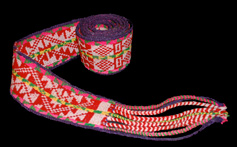Weaving Glossary
The following is a list of terms used in the exhibition Weaving Heritage.
Yarn: Continuous strands of cleaned spun fibers used in weaving. Several yarns can be twisted together to produce thread.
Warp: In weaving, the warp is the set of lengthwise yarns through which the weft is woven.
Weft: The weft yarns run horizontally and are interlaced with the warp yarns to create the woven textile.
Loom: A basic loom is a frame with warp threads strung along the length and secured at both ends. The loom’s primary function is to control the warp, which is prone to tangling. The weft threads, carried by a needle or bobbin, are woven horizontally over and under warp yarns row by row to make cloth.
Hand-woven: This describes material that is loomed by human hand. Each weaver has a unique style and skill level, making every hand-woven garment unique.
Machine-woven: This term indicates material that is woven by a mechanized loom.
Backstrap Loom:Backstrap looms are tied around the weaver's waist on one end and around a stationary object such as a tree, post, or door on the other. Tension can be adjusted simply by leaning back. Backstrap looms are very portable, since they can simply be rolled up and carried.
Batik: A method of resist dyeing by which the parts of the fabric not intended to be dyed are covered with removable wax. Multiple wax and dye applications create complex, multi-colored patterns on the fabric. Batik became a symbol of independence in Indonesia in 1949 when the Dutch ceded control of Indonesia after more than 300 years of colonial rule.
Embroidery: The ornamentation of fabric using needlework to create a design onto a base fabric.
UNESCO: The United Nations Educational Scientific and Cultural Organization states that “culture has intrinsic value for development as well as social cohesion and peace.” UNESCO has been instrumental in supporting the reclamation of traditional weaving in many cultures.
Weaving Resources
The Henry Art Gallery, also on the UW campus, has a useful site called Exploring Costume and Textiles, as well as an Embroidery Stitch Identification Guide that offers a comprehensive list of embroidery terminology.
Are you a weaver? Join one of many regional Weavers' Guilds! Visit the website of the Association of Northwest Weaver's Guilds for more information.
